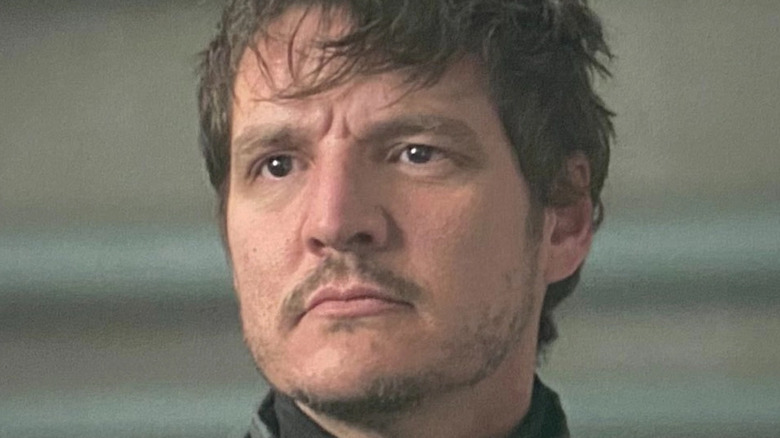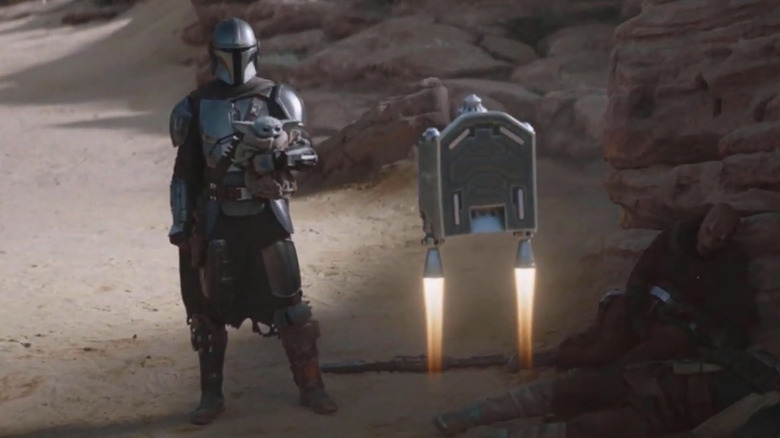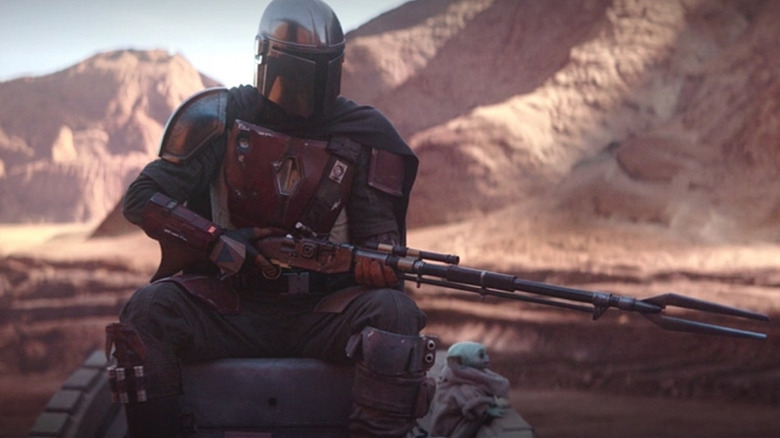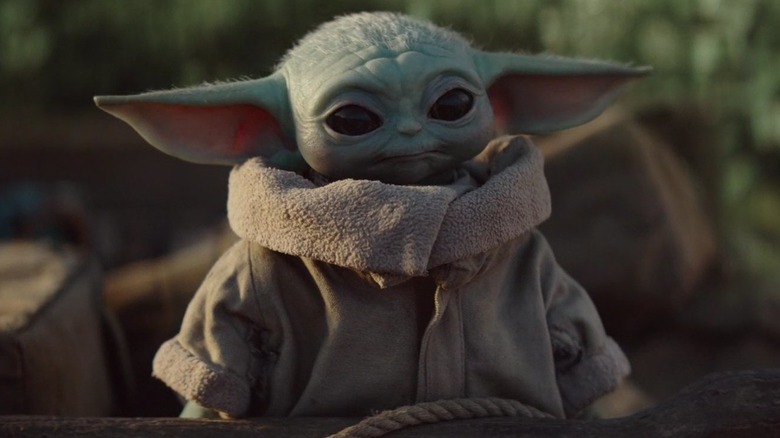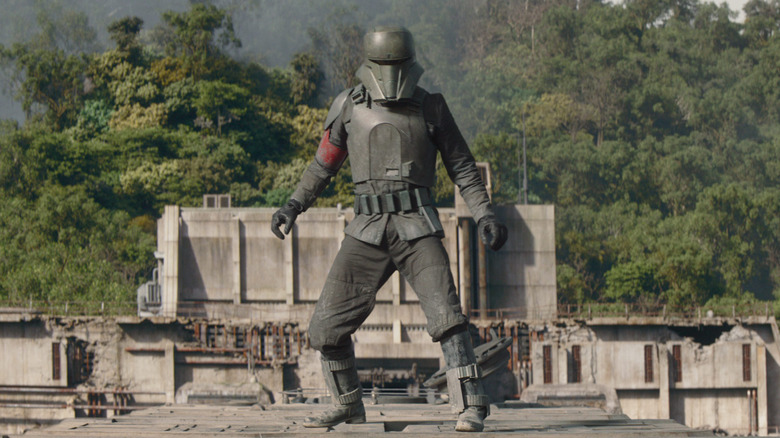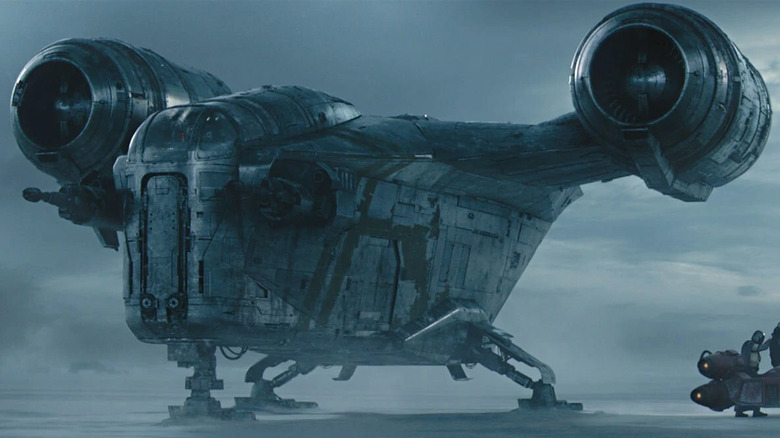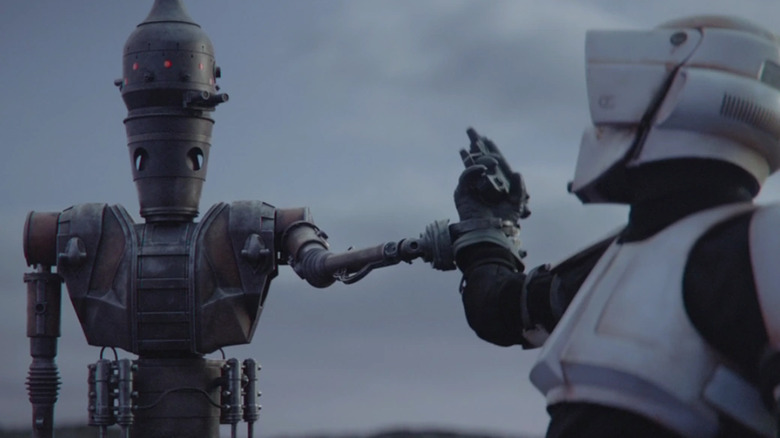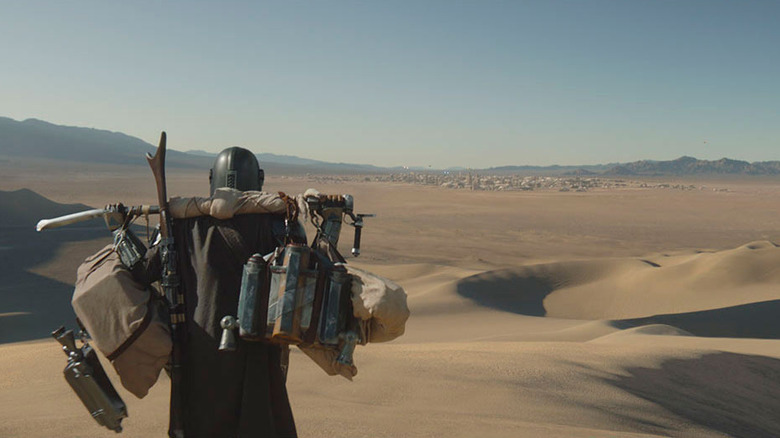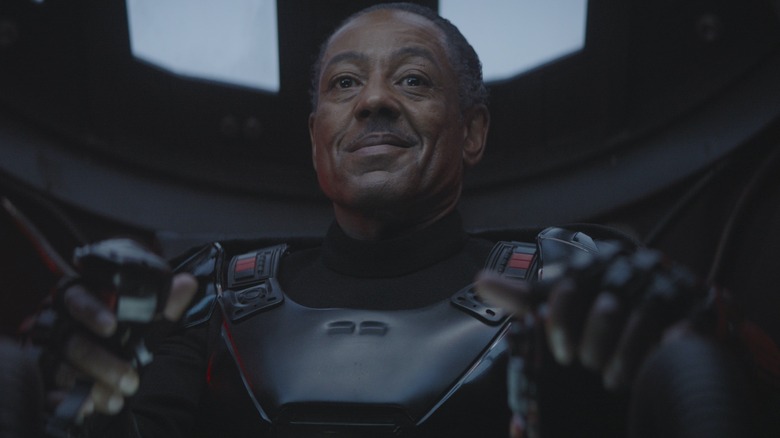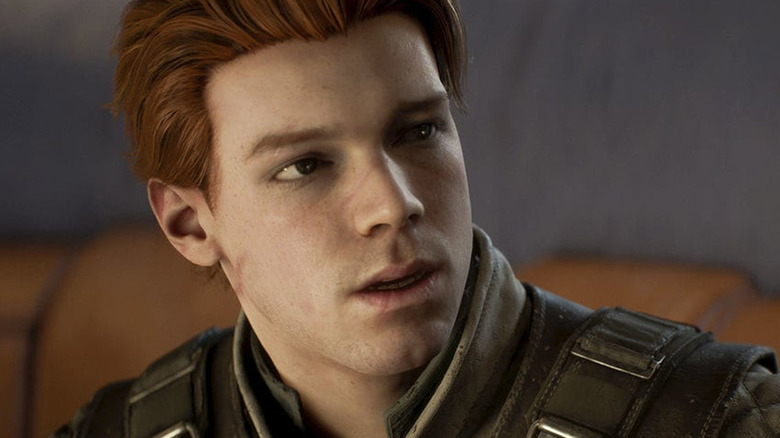Things The Mandalorian Game Can't Afford To Get Wrong
For almost as long as "Star Wars" films have existed, so too have there been "Star Wars" video games. The first "Star Wars" game, "The Empire Strikes Back," debuted in 1982 for the Atari 2600 and Intellivision. Its release occurred only five years after that of the original "Star Wars" film and one year before the conclusion of the original trilogy.
In recent years, "Star Wars" games have generally told original "Star Wars" stories, rather than adapting existing storylines. The last bastion of playable narratives taken directly from the films is the "Lego Star Wars" series. For instance, "Lego Star Wars: The Skywalker Saga," offers players the chance to play through a Lego-fied version of all nine entries in the mainline series of "Star Wars" films.
According to a purported leak, a video game based on the hit Disney+ series "The Mandalorian" is on its way, returning once again to the trend of adapting existing "Star Wars" material into non-Lego video game form. With that said, there are a number of important principles to which a "Mandalorian" game will have to adhere in order to deliver on its premise.
The Mandalorian needs a functional jetpack
Before the term "Mandalorian" was ever used to refer to a group of intergalactic warriors (many of whose ancestry originates on the planet Mandalore), Boba Fett appeared as an animated character in the notorious "Star Wars Holiday Special." Back then, Boba Fett was simply envisioned as an armored bounty hunter. Now, most "Star Wars" fans know Boba Fett as a clone of a Mandalorian warrior named Jango Fett. That said, in his animated debut and subsequent canonical film appearances alike, Boba Fett has worn a sizable jetpack on his back.
Following the precedent set by Fett, the masked protagonist of "The Mandalorian" also wears a jetpack for much of the series. Furthermore, his ability to fly with it becomes an important tool in his arsenal, especially over the course of the series' second season.
The video game version of "Mandalorian" protagonist Din Djarin, then, should be able to fly in some game segments at least, if not at the player's will. Without a functional jetpack, the "Mandalorian" game would be missing a key tool that is not only prominently featured in its televised source material, but one that has existed since the introduction of the first popular Mandalorian.
Players should have access to a variety of weaponry
Again dating back to the days of Boba Fett, Mandalorian warriors have almost always been depicted wielding blaster pistols. That said, a firearm is but one weapon utilized by the typical Mandalorian and not the focus of their arsenal, entirely unlike how a lightsaber is central to a Jedi's fighting style.
In the "Star Wars: Episode II – Attack of the Clones" fight between Obi-Wan and Jango Fett, for example, Jango Fett attack his adversary with a pair of blaster pistols, his jetpack's large missile, and a fireable cable attached to one of his gloves. Din Djarin similarly fights with a large arsenal of weapons over the course of "The Mandalorian," which includes his own jetpack missile, a flamethrower, and a set of small homing devices called "whistling birds."
A good "Mandalorian" game, then, should not rely solely on gun combat, but should instead offer players a range of options in combat. This would allow players to properly mimic Mando and virtually every other Mandalorian's various abilities. Allowing players to modify and/or otherwise customize a variety of tools could even serve to strengthen its virtual Mando as the game progresses.
Grogu shouldn't feel like a burden
It goes without saying that the "Mandalorian" video game should include a healthy dose of Grogu — once known colloquially as "Baby Yoda," despite the fact that Disney officially referred to him as simply "The Child."
Grogu was, at the very least, the breakout star of "The Mandalorian," if not its star sans qualification, depending on whom you ask. Given that Grogu is a (fifty-year-old) baby, direct player control over Grogu is essentially a non-starter. Grogu's Force sensitivity makes him a powerful ally, but his relative young age means that he can't utilize his Force powers with any sort of regularity. Giving players control over Grogu would nullify that core characteristic.
Since Grogu needs to be in-game but shouldn't be playable, he will almost assuredly be included as an NPC that accompanies the player-controlled Mando. That said, travelling with Grogu should never feel like a frustrating escort mission. Little would detract more from the inherent power fantasy of embodying a powerful Mandalorian warrior than being required to watch over a fragile NPC at all times. Rather, "The Mandalorian" can look to Atreus in "God of War" as a template for a weak but useful NPC companion.
A good Mandalorian game needs good side quests
Though none of the producers of "The Mandalorian" have seemingly described the series as being influenced by video games outright, many viewers, including "God of War" director Cory Barlog and GamesRadar+'s Bradley Russell have felt that the series' episodic nature evokes a series of video game sidequests. Some fans have even theorized that the show's premise was originally intended for a canceled "Star Wars" video game. Whether intentional or not, video game-style sidequests are already a part of the DNA of "The Mandalorian."
This is no more apparent than in the Season 2 episode "The Believer." Sequences like the one in which Mando battles waves of attackers atop a moving vehicle could essentially be reproduced beat-for-beat in video game form and closely resemble their inspiration. The "Mandalorian" video game could even take entire storylines from episodes of the series as fodder for a multitude of in-game adventures.
Since quote-unquote sidequests are such a big part of "The Mandalorian" already, a "Mandalorian" video game presents a unique opportunity to include further missions similar to those Din undertakes throughout the TV series. New sidequests could serve to build out the world of "The Mandalorian" in ways only a video game could.
The Razor Crest should be a central gameplay feature
In "Star Wars Jedi: Fallen Order," one of the few original AAA "Star Wars" game released in the wake of Disney's purchase of LucasFilm, a ship called the Stinger Mantis serves as a sort of hub for its protagonist Cal Kestis. Within the ship, players can choose from a variety of planets to visit, and even raise plantlife in a small garden that becomes populated when players identify particular plant life in their natural environments.
Over the course of "The Mandalorian," Din and Grogu spend a considerable amount of time in Mando's ship, the Razor Crest. Sometimes Mando pilots the Razor Crest in dogfights, while at other times it serves an important plot purpose, including the time it served as a getaway vehicle following the heist in Season 1's "The Prisoner."
In video game form, then, the Razor Crest should at minimum serve as a sort of home base in the same manner as the Stinger Mantis in "Fallen Order." Better yet would be to feature the Razor Crest as a functionally and/or cosmetically upgradable vehicle, even offering players full control of it in segments mimicking some of the dogfight scenes in the TV series.
Mando's allies deserve a chance to shine
"Star Wars" protagonists are oftentimes nothing without their allies and supporting cast. Luke Skywalker, for instance, famously enlisted the aid of Han Solo, Leia Organa, Lando Calrissian, and others. Anakin Skywalker likewise rarely succeeded on his own. Rather, he was strongest as part of a ragtag team that included the likes of the legendary Obi-Wan Kenobi and even Jar Jar Binks.
Like the Skywalkers before him, Din Djarin is not a lone wolf, but is instead dependent on a large rotating cast of companions. Mando's allies range from murderous droid IG-11 to none other than "Star Wars" series mainstay Boba Fett.
Since Mando's companions factor so prominently into most episodes of the TV series, it would be a shame to relegate them to the sidelines in a "Mandalorian" video game. At minimum, ally NPCs with dynamic and unique behaviors in combat could help replicate the feeling established in the series, that Mando fights best with others at his side. Even better yet would be an option to recruit controllable allies in the manner of "Knights of the Old Republic."
A dynamic soundtrack is a necessity
The success of the original "Star Wars" is inseparable from its iconic score by John Williams. The opening crawl of the first moments of the original "Star Wars" film, underscored by Williams' Main Title theme, arguably ranks among the most recognizable sequences in film history. The original Ludwig Göransson score featured in "The Mandalorian" seems meant to replicate that key element of classic "Star Wars" films.
The soundtrack to "Mandalorian" can be loud and bombastic, swelling during big moments, or slow and mysterious when meant to underscore its quieter moments. Göransson's main theme for the series has been viewed nearly 9 million times on YouTube, reflecting just how potent of an effect the "Mandalorian" score has had on viewers.
To truly feel like "The Mandalorian," a video game version of the series should include a facsimile of the series' signature music. Featuring key songs from the series might be enough to capture the magic already established on screen. Taking things one step further, a score that adapts musical passages to gameplay in the manner of "Breath of the Wild" could truly help players feel like a part of the living, breathing world of "The Mandalorian."
Moff Gideon should be a major antagonist
The presence of Moff Gideon, portrayed by "Breaking Bad" actor Giancarlo Esposito, looms large over "The Mandalorian." That said, after adding up both his brief presence in Season 1 and all of his scenes in Season 2, Gideon only appears on screen for less than 7 minutes total. While this may just be a result of enlisting a big name star for the role, the producers of "The Mandalorian" may have simply decided that the character is more menacing and when used sparingly.
In either case, Moff Gideon should factor significantly into a "Mandalorian" video game. In theory, a video game adaptation of "The Mandalorian" could be an ideal opportunity for Gideon to factor more prominently into Madno's journey, untethered to Esposito's in-person availability. Furthermore, a "Mandalorian" game will presumably tell at least some new stories, rather than simply retreading the exact story beats of the series before it. Additional story content could provide new opportunities for the series' most gripping villain to further shine.
A Mandalorian game should reference other Star Wars properties
For better or for worse, the interconnectedness of "The Mandalorian" with other "Star Wars" properties remains a key component of its first two seasons. In Season 1, for example, Mando visits the Mos Eisley cantina on Tatooine, an iconic location from the original "Star Wars" film. In Season 2, the series' connections to past and future "Star Wars" properties become even more flagrant. Season 2 episode "The Jedi," for example, establishes a live action version of Ahsoka Tano, who is set to serve as the protagonist of an upcoming Disney+ series.
While moments like these play to nostalgia and/or encourage viewers to tune into new "Star Wars" releases, they also help unite the various story threads throughout "Star Wars" history into a larger whole. The release of a "Mandalorian" video game presents a unique opportunity to approach other "Star Wars" video games in the same way as its predecessor does movies and TV series. Cameos or references to Cal Kestis, Revan, or other classic video game characters could truly help replicate the interconnected nature of "The Mandalorian."

